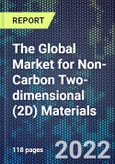Graphene has brought to the world’s attention the exceptional properties of two-dimensional (2D) nanosheet materials. Due to its exceptional transport, mechanical and thermal properties, graphene has been at the forefront of nanomaterials research over the past few years. Its development has enabled researchers to explore other 2D layered materials, such as the transition metal dichalcogenides, a wide variety of oxides and nitrides and clays.
Researchers have therefore looked beyond graphene in recent years to other layered 2D materials, such as borophene, molybdenum disulfide (MoS2), hexagonal boron nitride (h-BN) and phosphorene. These materials possess the intrinsic properties of graphene, such as high electrical conductivity, insulating and semi-conducting properties, high thermal conductivity, high mechanical strength, gas diffusion barriers, high chemical stability and radiation shielding, but crucially also possess a semiconductor band gap. Theoretical and experimental works on these materials have rapidly increased in the past couple of years and they are now commercially available from several advanced materials producers.
Non-carbon 2D materials covered in this report include:
- borophene.
- molybdenum disulfide (MoS2).
- hexagonal boron nitride (h-BN).
- phosphorene.
- graphitic carbon nitride.
- germanene.
- graphane.
- graphdiyne.
- stanene/tinene.
- tungsten diselenide.
- rhenium disulfide.
- diamene.
- silicene.
- antimonene.
- indium selenide.
Markets these materials could significantly impact and are covered in this report include:
- Electronics.
- Batteries (Lithium-ion, sodium-ion, lithium-sulfur, lithium-oxygen).
- Sensors.
- Separation membranes.
- Photocatalysts.
- Thermoelectrics.
- Photovoltaics.
Report contents include:
- Properties of non-carbon 2D materials.
- Applications of non-carbon 2D materials.
- Addressable markets for non-carbon 2D materials.
- Non-carbon 2D materials roadmap.
- Production and pricing.
- Profiles of 2D materials producers. 23 companies profiled.
This product will be delivered within 1-3 business days.
Table of Contents
Companies Mentioned (Partial List)
A selection of companies mentioned in this report includes, but is not limited to:
- 2D fab AB
- 2D Fluidics Pty Ltd
- 2D Layer
- 2D Semiconductors
- Advanced Material Development (AMD)
- Applied Nanolayers BV
- Bedimensional S.p.A
- BioGraph Solutions
- Cambridge Graphene Ltd.
- Evercloak, Inc.
- FlexeGRAPH
- GoLeafe
- HQ Graphene
- LeaderNano Tech LLC
- Merck
- Ossila Limited
- Paragraf Ltd.
- Planartech LLC
- Rusgraphene
- Sigma-Aldrich Corporation
- Smart Elements GmbH
- SPI Supplies
- XlynX Materials Inc.
Methodology

LOADING...








